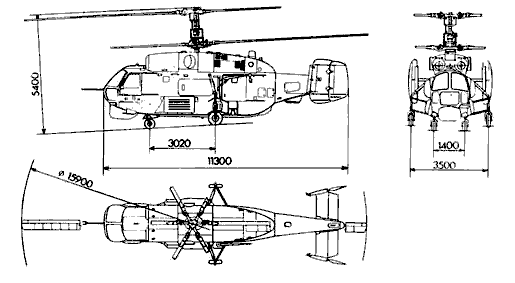|
|
 |
Mi-26
The Mi-26 helicopter, the heaviest and most powerful helicopter in the world, was designed for carrying large-size cargoes weighing up to 20 tons. It is the result of an early 1970s specification for a transport helicopter whose empty weight, without fuel, was not to exceed half of its maximum take-off weight. It can be used for construction projects ranging from bridges to power transmission lines. The combination of high load-carrying capacity and high cruise speed makes the use of the helicopter economically efficient.
The helicopter is loaded through the cargo hatch in the tail of the fuselage with lowered ladder and subladders. The cargo cabin is equipped with two electric hoists and lifting and loading devices ensuring loading and carrying along the cabin of cargoes weighing up to 5 tons.
The Mi-26 is the first helicopter with an eight-blade main rotor, which is mounted above the fuselage midsection on a hump. Two turboshaft engines are mounted on top of the cabin with round air intakes above and behind the cockpit and exhaust ports at the sides of the engines. The long, bus-like body with fixed tricycle landing gear tapers to the nose and rear, with an upswept rear section and rounded nose and stepped-up cockpit. The tail is swept-back with a slightly tapered fin with large rotor on right side. The flats are forward-tapered and low-mounted on leading edge of the fin.
The load and lift capabilities of the aircraft are comparable to the US C-130 Hercules transport aircraft.
|
Specifications
| | Country of Origin | Russia
| | Builder | MIL
| | Date of Introduction | 1983
| | Role | Heavy cargo-transport
| |
Blades | Main rotor - 8
Tail rotor - 5
| | Rotor diameter | 105 ft (32 m)
| | Length | 111 ft (33.8 m)
| |
Length (rotors turning) | 40 meters
| |
Length (fuselage) | 33.5 meters
| |
Width | 8.2 meters
| | Height | 26 ft., 5 in. / 8.1 meters
| |
Tail Rotor Diameter | 7.6 meters
| |
Cargo Compartment Dimensions |
12 meters - Floor Length
3.3 meters - Width
Height variable from 2.9 to 3.2 meters
| | Weight |
49500 kg - Normal takeoff weight
56000 kg - Maximum takeoff weight
28200 kg - empty weight
20000 kg - Load-lifting capacity
(100+ equipped troops, armored vehicles)
| | Engine | 2 x 11,400 shp Lotarev D-136 turbines
| | Maximum speed | 295 km/h
| | Cruising speed | 183 mph / 255 km/h
| | Range |
1200 km with Aux Fuel
800 km with maximum fuel reserve
475-800 km with maximum loading
| | Service Ceiling | 4600 m
1,800 m Hover (out of ground effect)
4,500 m Hover (in ground effect)
| |
Fuel | 11,900 liters Internal
| | AVIONICS |
The avionics and navigational package, a
Doppler weather radar, and a fully functioning
autopilot allow for day/night all-weather
operation.
| | Crew | 5 (2x pilots, 1x navigator, 1x flight engineer, 1x loadmaster) |

Ka-32
There are two versions of the Ka-32 helicopter: transport Ka-32T and shipborne Ka-32C.
The Ka-32T version is designed for transporting cargoes inside the cabin and and externally (for oversized cargoes), passenger transportation, logging in hard access areas, to fulfill civil engineering and installation work, construction, search/rescue missions, medevac and off-shore oil rings servicing operations and various types of aerial survey.
The Ka-32C version is designed for carrying out ice prospecting during the steering of the convoys of ships, their unloading, performance of rescue operations at sea and acting as ambulances. The Ka-32 has two TVZ-117 turboprop engines which provide higher power and safety under extreme conditions.
Transport version, KA-32T, is devoted to carry cargoes both internally
|
Specifications
| | Country of Origin | Russia
| | Builder | Kamov
| | Rotor Span | 51.64 ft/15.75 m
| | Length | 34 ft/10.4 m
| | Height | 18 ft/5.5 m
| | Weight | 11,000 kg
| | Engine | TB 3-117 VM
|
| Speed |
260 km/h Max. allowable flight speed
205 km/h Cruising speed at 1,500 m with 9,600 kg weight
115 km/h Economy speed at 1,500 m with 9,600 kg weight
|
| Ceiling |
5000 meters |
| Cruise range |
432 nm |
| In-Flight Refueling |
No |
| Internal Fuel |
432 kg |
| Payload |
800 kg |
| Crew |
1 minimum |

|


